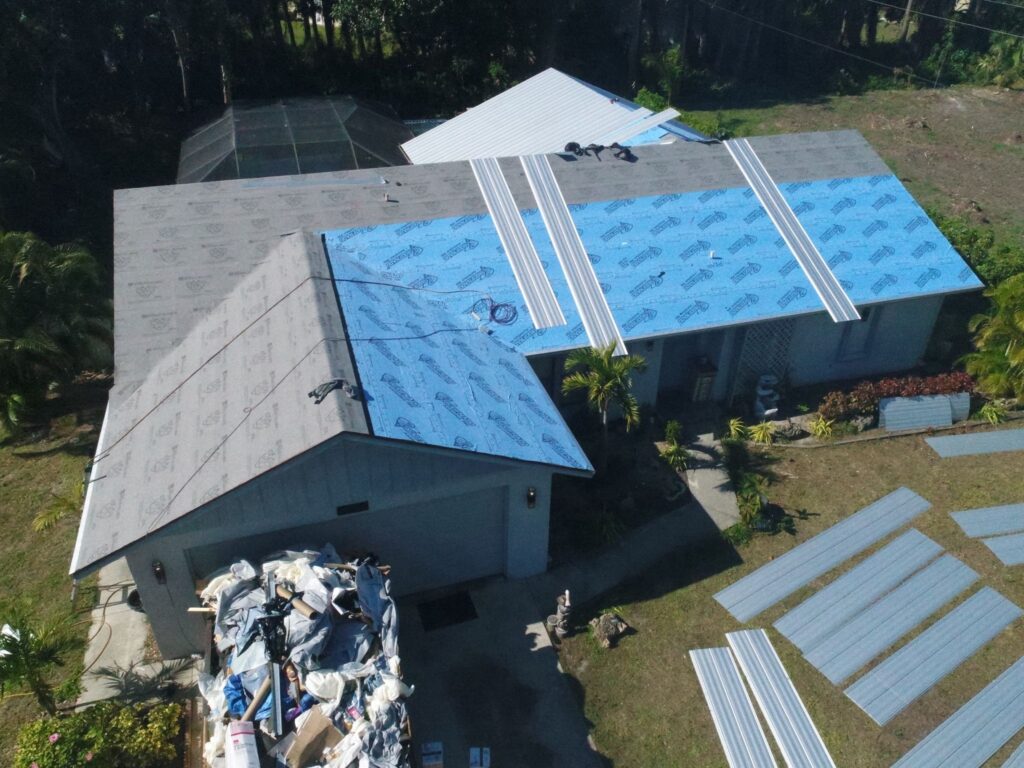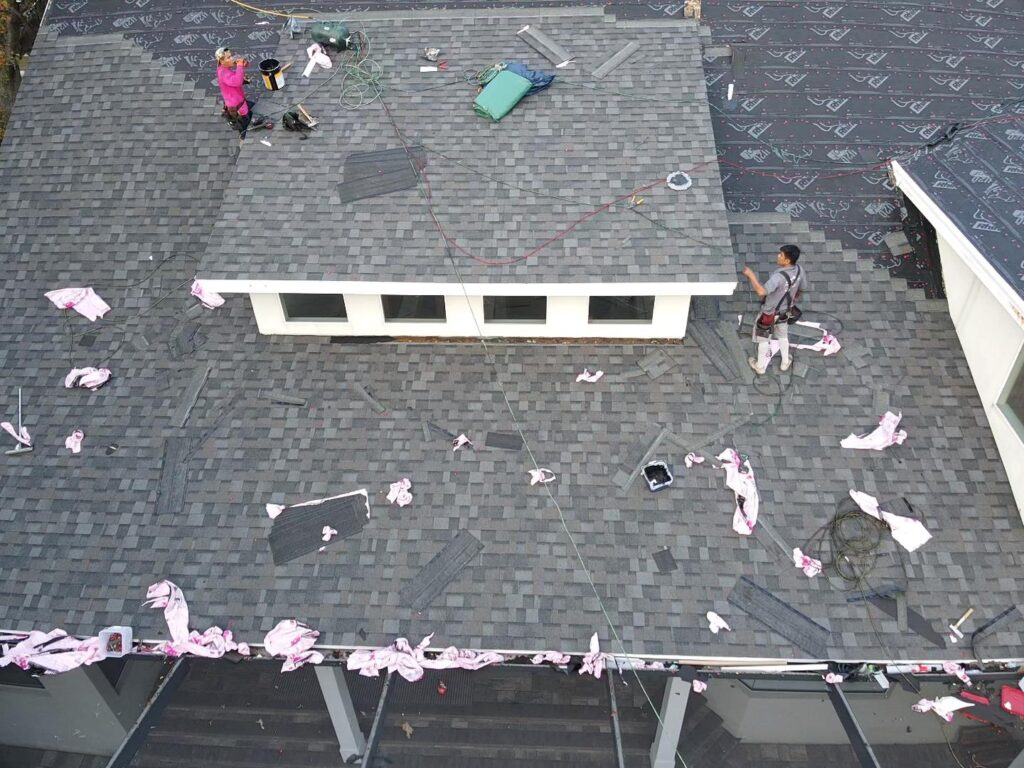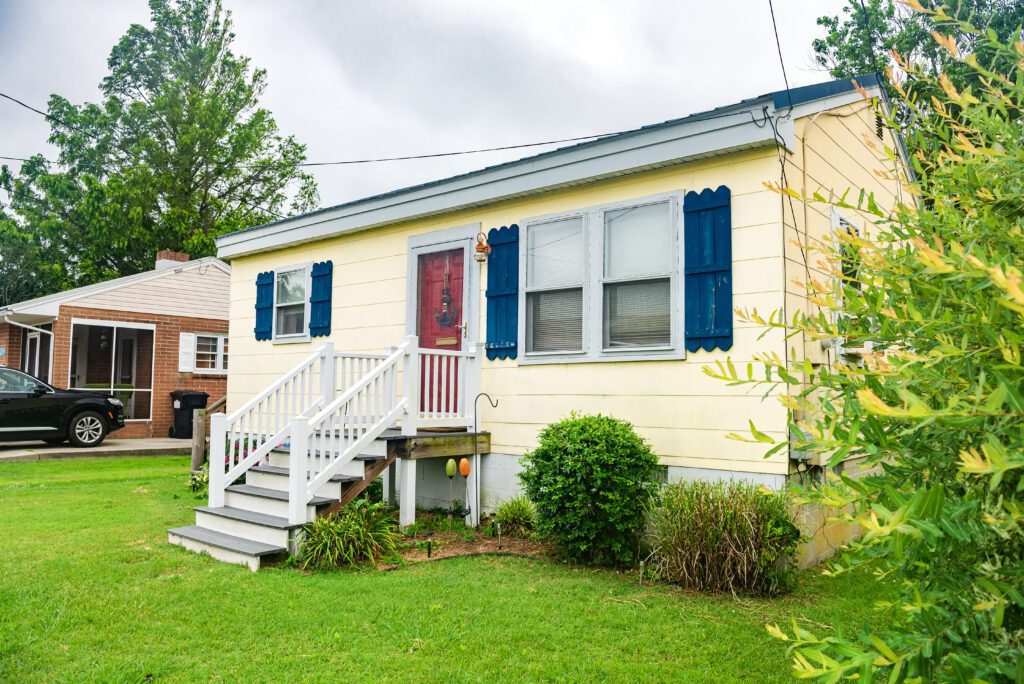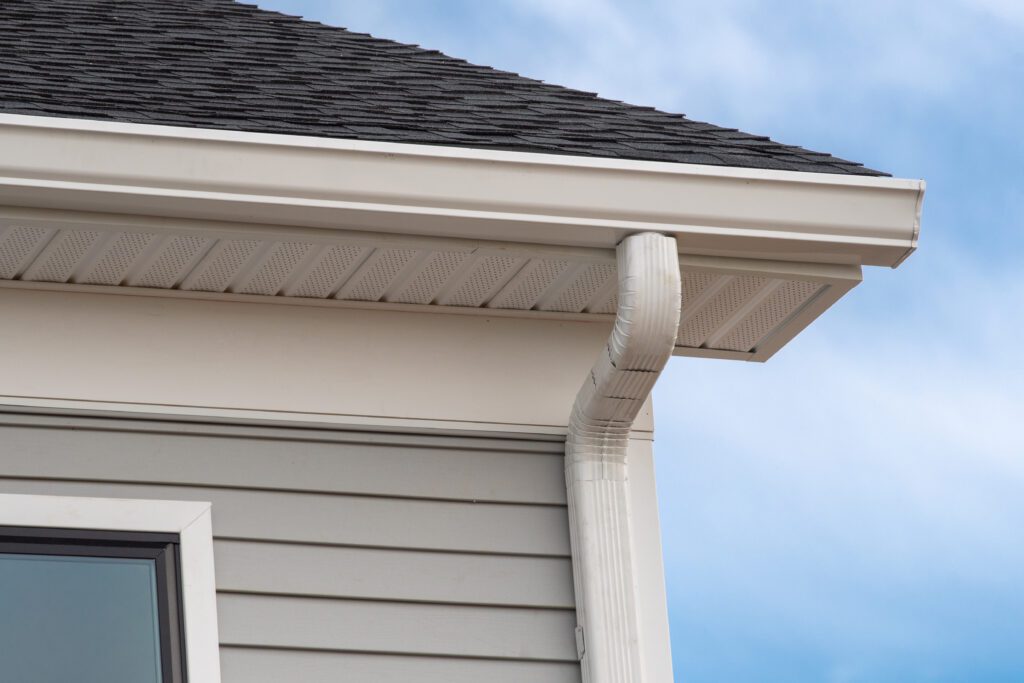As a homeowner or property manager, knowing about roof installation is key. It ensures your project is successful and affordable. In this guide, we’ll cover the basics of roof installation in 2025, including costs, materials, and the installation process.
Asphalt shingles cost between $100 to $400 per square (100 square feet). Labor can be up to 60% of the total cost. It’s important to make smart choices for your roofing project. Our guide will help you understand what affects prices, like material choices.
We’ll give you a detailed timeline for roof installation. It includes site inspection, material selection, and installing the new roof. By following our guide, you’ll know how to choose the best for your property. This ensures a durable roof that lasts for years.
If you’re thinking about a roof replacement or a new construction, our guide is for you. It covers everything from roofing costs to choosing materials and finding experienced contractors. We’re here to help you every step of the way.
Understanding Roofing Costs in 2025
As a homeowner, your roof is a big investment. In 2025, a new roof can cost between $5,855 and $13,113, averaging $15,000. But costs vary based on roof size, complexity, materials, and where you live.
Factors That Influence Roof Installation Prices
When getting a new roof, several factors affect the cost. The size of your roof is key, as bigger roofs need more materials and work, raising costs. The roof’s design, including its slope and features, also matters. Steeper roofs cost more because they’re harder to work on.
The type of roofing material you choose is also important. Asphalt shingles are the cheapest, costing $4 to $7 per square foot. But materials like metal, tile, and slate, which last longer, can cost up to $40 per square foot. Where you live also impacts costs, as labor and materials prices differ by area.
Asking the right questions before hiring a roofer can help you get good work for a fair price.
Average Cost of a New Roof in 2025
Here are some average costs for common roofing materials in 2025 for a 1,000 square foot roof:
- Asphalt shingles: $4,350 – $7,000
- Metal roofing: $5,000 – $12,000
- Tile roofing: $11,000 – $20,000
- DaVinci roofing: $8,000 – $15,000
Remember, these prices can go up for bigger roofs. For instance, a 3,000 square foot roof with asphalt shingles might cost between $13,050 and $21,000. A tile roof of the same size could be $33,000 to $60,000. Labor for a new roof usually costs $200 to $350 per square area, or about $2 per square foot.
Knowing what affects roof prices and the average costs of different materials helps you make a smart choice for your 2025 roofing project.
Choosing the Right Roofing Materials
Choosing the right roofing material for your home involves several key factors. These include durability, energy efficiency, and cost. With many options available, it’s important to consider each material’s pros and cons. This ensures you make a choice that fits your needs and budget.
Asphalt Shingles
Asphalt shingles are a favorite among homeowners because they’re affordable and easy to install. They usually come with a 20 to 30-year warranty. Architectural shingles, which are thicker, offer up to 30 years of protection.
Metal Roofing
Metal roofing is a great choice for those looking for durability and energy efficiency. It can last up to 50 years with proper installation. Metal roofs also resist hail and UV damage well, making them a wise investment.
Tile Roofing
Tile roofing, including ceramic and concrete, adds a unique and attractive look to homes. Ceramic tiles are light, absorb less moisture, and can last 60 to 80 years or more. Concrete tiles, though heavier, can last 50 years or more with regular sealing.
TPO Roofing
TPO (Thermoplastic Polyolefin) roofing is ideal for flat or low-slope roofs. It’s energy-efficient, resistant to UV and chemicals, and lasts long. TPO is also light and easy to install, saving on labor costs and time.
When picking a roofing material, think about roof pitch, budget, lifespan, and maintenance. Consulting with a professional roofing contractor can help you choose the best material. This ensures your home is well-protected and its value is enhanced.
Factors Affecting Your Roof Installation Timeline
Planning a roof installation project means knowing what can slow it down. Some things you can control, others you can’t. Knowing these factors helps you and your contractor plan better and avoid delays.
Weather is a big factor. Rain, snow, wind, and extreme temperatures can stop work. Spring and fall are best for roofing because the weather is mild and there’s less rain. Your contractor will watch the weather and adjust the schedule to keep everyone safe and your roof intact.
The type of roofing material affects the timeline too. Asphalt shingles are quick, taking 1-3 days. But slate or metal roofing takes longer, 6-14 days, because of how they’re installed. Custom materials might need more time for making and getting to you, so plan for that.
The size and design of your roof also matter. Bigger roofs take longer to work on. Roofs with many angles or special features take even more time. Your contractor will look at your roof and tell you how long it will take.
Getting permits and following local building codes can also slow things down. Your contractor will help with permits and inspections. If there are delays, it’s good to know early and talk often with your contractor.
Who you choose to do the roofing matters too. Busy contractors might have a long waitlist. But bigger teams can work faster. Ask your contractor about their schedule and how soon they can start and finish your job.
Understanding these factors and working with your contractor helps plan your roof project well. Be ready for delays and keep talking to avoid problems. This way, your roof installation will go smoothly.
Preparing for Your Roof Installation Project

Before your roof installation starts, it’s key to prepare well. This ensures a smooth process and protects your property. It also helps the roofing crew work safely and efficiently. Let’s look at some important steps for roof installation preparation.
Obtaining Necessary Permits and Inspections
Getting the right permits and inspections is a must. Building codes differ by area, so your contractor will guide you. These permits check if your roof meets safety and quality standards. Also, inspections during the project confirm the work is done right and follows the rules.
Clearing the Work Area and Protecting Your Property
To ensure a safe roof installation, clear the area and protect your property. Move outdoor furniture, plants, and decorations away from your home. This space helps the crew work without damaging your stuff. Also, park your cars elsewhere to avoid damage from falling debris.
Inside, protect fragile items from the roofing work’s vibrations. Take down wall decorations, and cover or move attic items to avoid dust and debris. Tell your neighbors about the project to help them prepare.
More ways to protect your property include:
- Trimming tree branches and shrubs near the roof for easy access
- Covering attic items with plastic sheets or tarps
- Securing windows with boards to prevent damage
- Ensuring the crew has power outlets, preferably outside or in the garage
By following these roof installation preparation steps, you can reduce disruptions and damage. Work with your contractor to make a detailed checklist. This way, you can have a successful and worry-free roof installation.
The Roof Installation Process: A Step-by-Step Guide

Replacing your roof? Knowing the installation process is key for a great result. A pro will follow steps to install your new roof right. Let’s explore each stage.
Removing the Old Roofing Material
The first step is removing the old roof. The crew will take off the shingles, underlayment, and flashing. They’ll also get rid of them properly. This step helps find any roof deck problems before the new roof goes on.
Inspecting and Repairing the Roof Deck
After removing the old roof, the contractor checks the roof deck. They look for damage like rot or water leaks. If they find any, they’ll fix it to make sure the new roof has a solid base.
Installing Underlayment and Flashing
Next, they put on a water-resistant underlayment for extra moisture protection. They also add flashing around chimneys and vents. This stops water from getting in.
- Ensure proper placement of the drip edge
- Fasten rows of underlayment with cap nails
- Overlap rows by 6 inches for seam protection
- Secure the final drip edge
Laying the New Roofing Material
Now, they start putting on the new roofing material. This can be asphalt shingles, metal, or tile. They make sure each piece is right, for a weatherproof roof.
The contractor follows best practices and guidelines. This ensures your roof lasts a long time. After finishing, they inspect and clean up, leaving your place looking good.
Navigating Roof Installation Challenges
Getting a new roof can make your home more energy-efficient and look better. But, it’s not easy. Homeowners and contractors face many obstacles during the process.
Working Around Weather Conditions
Weather delays are a big problem. Rain, wind, or extreme temperatures can slow down or ruin the job. Contractors need to be flexible and work around bad weather to keep everyone safe and the job done right.
It’s smart to plan the roof job for a better season. But, sometimes the weather doesn’t cooperate. Talking openly with the contractor and homeowner helps adjust plans when unexpected weather hits.
Addressing Unexpected Structural Issues
Structural problems can pop up during roof work. When the old roof comes off, hidden issues like rotten wood or pests might be found. These problems must be fixed before putting on the new roof to keep the building safe.
If structural issues are found, more repairs might be needed. This can change the project’s timeline and cost. A good roofing contractor will check the roof deck and tell you what repairs are needed. This ensures the new roof has a strong base.
Maximizing Your Roof’s Lifespan: Maintenance Tips
We’ve helped homeowners for over 30 years. We know how key regular roof care is. By following the essential roof maintenance tips, you can make your roof last longer and avoid expensive fixes later.
First, check your roof decking. It’s where your roofing materials sit. Look for discoloration, which might mean water damage and rot. Also, inspect the decking’s underside from your attic for leaks.
Keeping your gutters clean is vital. It stops water damage, rot, and mold.
Clear debris from your roof, like in roof valleys, to avoid water blockage and shingle damage. Also, trim tree limbs three feet from your roof. This reduces water, sap, debris, and bird droppings’ harm to your roof.
- Inspect shingles for granule loss, curling, cracking, and missing pieces
- Check around roof penetrations like vents, pipes, chimneys, and skylights for leaks
- Ensure flashing is in good condition to direct water away from leak-prone areas
While DIY roof care might seem appealing, hiring a roofing pro is safer. They can spot and fix issues you might miss. DIY can be risky and might void warranties.
Roof inspections, twice a year, can catch problems early. This can extend your roof’s life. Asphalt shingles last 20 to 25 years, while metal roofs can go over 50. Quality materials, ventilation, and insulation also help your roof last longer.
Selecting the Right Roofing Contractor for Your Project
Finding the right roofing contractor is key to a successful roof job. Start by researching online, as 81 percent of shoppers do before buying. Look for contractors with over 30 years of experience.
Verifying Licenses, Insurance, and Certifications
Make sure your contractor has the right licenses, insurance, and certifications. Licenses show they’re professional and skilled. They should also have general liability and workers’ compensation insurance to protect you and your property.
Evaluating Experience and Reputation
Check a contractor’s experience and reputation by looking for:
- At least five years in business
- A physical office and local phone number
- Positive Google reviews from the last 3-6 months
- References from jobs completed in the past 3 to 6 months
- Authorized installer or preferred partner status with the shingle manufacturer
Be careful of contractors with less than three years of experience. Get at least three estimates from trusted contractors before deciding.
Understanding Warranty Coverage and Guarantees
Know the warranty and guarantees your contractor offers. Look for a written workmanship warranty of at least two years. Choose contractors who are authorized installers or preferred partners for honored warranties. Avoid contractors who promise to cover insurance deductibles, as this is not common.
By carefully researching and following these tips, you can find a reliable roofing contractor. They will ensure a quality roof installation and give you peace of mind.
Financing Your Roof Installation in 2025
Financing your roof in 2025 requires careful planning and exploring different options. The average roof replacement costs about $11,000. Prices can vary from $6,000 to over $50,000 for top materials. It’s key to plan and pick the right financing for your budget.
Budgeting for Your Roofing Project
To make a solid roofing project budget, get detailed estimates from trusted contractors. Remember, materials are 40% of the cost, and labor is the rest. The size of your roof also affects the price, with costs from $4,500 to $10,000 per thousand square feet.
Don’t forget to add extra costs like permits, inspections, and unexpected repairs. This will make sure your budget covers everything.
Exploring Financing Options and Payment Plans
Homeowners have many roof installation financing choices. Home equity loans and personal loans usually have lower interest rates than contractor financing or credit cards. It’s important to look at the terms, rates, and repayment plans of each option to find the best one for you.
Many roofing companies offer their own roof financing options or payment plans. These can be handy but might have higher interest rates. Make sure to compare these offers with other loans to get the best deal.
By doing your homework on financing, making a detailed budget, and choosing a reliable contractor, you can smoothly go through the roof installation process. This will help protect your home for many years.
Conclusion
The Ultimate Roof Installation Guide for 2025 has given homeowners the tools they need. It helps them understand how to install a new roof. Knowing about roofing costs, like materials and labor, lets homeowners plan their budgets well.
Choosing the right roofing material is key. Options like asphalt shingles, metal, and tile offer different benefits. They vary in durability, energy efficiency, and looks.
Before starting a roof installation, homeowners need to get permits and clear the area. They should pick a reliable roofing contractor. A detailed guide shows how to install a roof correctly, from removing the old material to adding underlayment and flashing.
Knowing about possible problems, like bad weather or structural issues, is important. This way, homeowners and contractors can work together for a successful installation.
Keeping a roof in good shape is essential for its long life and to avoid expensive fixes later. Homeowners should look into financing options to make the project easier. With careful planning and execution, a new roof can protect a home for years, save on energy, and increase its value.
By following the advice in this guide, homeowners can confidently install a durable roof. They will enjoy its benefits for many years.
FAQs About Roof Installations
How much does a new roof installation cost in 2025?
In 2025, the cost of a new roof can range from $9,855 to $25,113. This depends on the roof’s size, complexity, materials, and where you live.
What factors influence roof installation prices?
Several things affect roof installation costs. These include the roof’s size and complexity, the materials used, labor costs, and where the property is located.
What are the most common roofing materials?
Common roofing materials are asphalt shingles, metal, tile, and TPO. Each has its own benefits like cost, durability, energy efficiency, and looks.
How long does a roof installation project typically take?
Roof installation times vary. It depends on weather, roof design, contractor availability, and permits. Homeowners should plan with their contractor for a realistic timeline and delays.
What should I do to prepare for a roof installation project?
To prepare, get necessary permits and schedule inspections. Clear the area and protect your landscaping, vehicles, and furniture. A checklist with your contractor can help.
What are the main steps in the roof installation process?
The main steps include removing old material, inspecting and repairing the deck, installing underlayment and flashing, and laying new material. Proper techniques are key for a long-lasting roof.
How can I maximize the lifespan of my new roof?
To extend your roof’s life, get annual inspections, clean gutters, trim trees, and fix any damage quickly. These steps protect your investment and ensure performance.
What should I look for when choosing a roofing contractor?
Look for valid licenses, insurance, and certifications in a contractor. Check their experience, reputation, and reviews. Understand warranties and guarantees too.
What financing options are available for roof installation projects?
Financing options include home equity loans, personal loans, and contractor plans. Review terms, interest, and repayment to choose wisely based on your budget.
How can I find a reliable roofing contractor in my area?
Ask for referrals, search online, and check credentials. Schedule consultations to compare contractors’ expertise, communication, and prices for the best choice.





